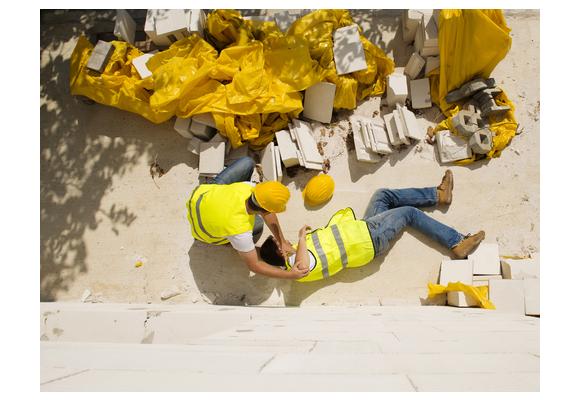
A Complete Overview on Preventing Falls in the Workplace
It’s extremely important to prevent falls in the workplace, as thousands of workers injure themselves from fall accidents every year, which in severe cases can result in death. For employers, these lost-time injuries can be expensive in regards to workers’ compensation costs.
Causes of falls
According to recent statistics, 66% of falls occur on the same level due to slips and trips, whereas 34% of falls are from heights. Slips are usually caused by little traction between someone’s shoes and the floor’s surface, while trips occur when someone’s foot accidentally hits an object that causes them to lose balance and then fall. When someone falls from a height, they can either fall from a ladder or roof, down the stairs, or trying to jump to a lower level.
Managing the risk of falls
1. Identify fall hazards - Identify locations, tasks and work areas that could cause fall accidents. While inspecting the workplace, talk to your workers about any areas or objects that could result in falls, and make a checklist of these. Also review your records of fall injuries and near-miss incidents that happened before.
2. Asses the risks - A risk assessment will allow you to know if the associated risks of fall hazards are severe, if control measures are effective, what you should do to control the risks, and whether you should take immediate action.
3. Control the risks -
Preventing falls resulting from slips and trips
a) Good housekeeping Clean spills straight away, mark spills/wet areas, mop or sweep floor debris, remove obstacles/clutter from walkways, and secure mats, rugs and carpets with tacks/tapes. Also close cabinets/drawers, cover cables, keep work areas and walkways well lighted, and replace burnt out light bulbs and defective switches.
b) High-tech flooring Recoat or replace floors, and install mats, abrasive coating, or metal/synthetic decking. Anti-slip mats made of nitrile rubber are resistant to grease, fats, oils and chemicals. They also provide comfort underfoot with cushioning, which can prevent and reduce foot fatigue and therefore prevent slips from occurring. Anti-slip mats can be used in wet areas, as well as kitchens, factories, hotels, resorts, restaurants, and takeaway shops. They have medium-sized drainage holes that enable liquids to flow through the mat, which keeps the surface dry and non-slippery. On the sides and surface of the mat is a grip pattern that keeps it firmly in place, preventing it from moving on the floor and offering traction when people walk over it. You can also install abrasive strips like non-slip tapes. These are durable and can be used on stairs and ramps, and in medium-traffic environments such as bars, bathrooms, beverage dispensary areas, buildings, and factories. They offer high-level traction in areas that are slippery, and with their coarse surface and adhesive backing, you can place them on smooth, clean surfaces.
c) Proper footwear Wear the right shoes in oily, wet, or outdoor areas. Make sure your shoes are fitted properly and comfortable to walk in. This will prevent fatigue and increase your safety.
d) Appropriate walking pace and actions To prevent slipping on wet floors, take your time and pay attention to where you’re going, adjust your stride to a suitable pace according to the floor surface and your tasks, walk with your feet pointed a little outward, and make a wide turn at corners. To prevent tripping, keep walkways clear of clutter and obstructions, keep floors in good condition, use light sources that will offer enough light to complete your tasks, use a flashlight when entering dark rooms with no lights, and ensure that the things you carry and push don’t block your view of obstructions or spills.
Preventing falls from heights
a) Work on ground level or on a solid construction You can eliminate hazards and their associated risks by ensuring that work with fall hazards are carried out on ground level or on a solid construction. Solid constructions should have structural strength, protection for edges/opening/holes, non-slippery surfaces and gradients, and safe entrances and exits.
b) Use fall prevention systems Minimise the risks of falls by using a passive fall prevention device (e.g. scaffolds, elevating work platforms, mast climbers, workboxes, building maintenance units, trestle ladder-supported platforms, guard rails, safety meshes), a work positioning system (i.e. rope access systems, travel restraint systems using safety belts/harnesses and lanyards), or a fall arrest system (e.g. catch platforms, safety nets). You can also use ladders (i.e. portable/fixed ladders, ladder and tower safety systems with double lanyards), administrative controls (e.g. ‘no go’ areas, permit systems, organising/sequencing of work, safe work procedures), and other reasonable, practical steps (i.e. fragile roof surfaces should be covered with brittle material, fix all grid mesh/checker plate floor panels securely).
4. Implement and review control measures - When implementing risk control measures, you should develop work procedures that outline the correct ways to install, use, and maintain fall prevention systems, as well as provide your workers with information, training sessions and instructions. Control measures must be reviewed and, if necessary, revised on a regular basis to ensure that they work. Involve your workers and health and safety representatives during the review process. Also inspect and maintain equipment and check the manufacturer’s/supplier’s guidelines. Always eliminate fall hazards in the workplace. When designing plants and building structures, it’s important to consider the potential risks of fall hazards. This could enable you to eliminate fall hazards completely or otherwise have better risk control. You can minimise risks during the design stage and prevent future falls by integrating anti-slip flooring and fall prevention systems.

